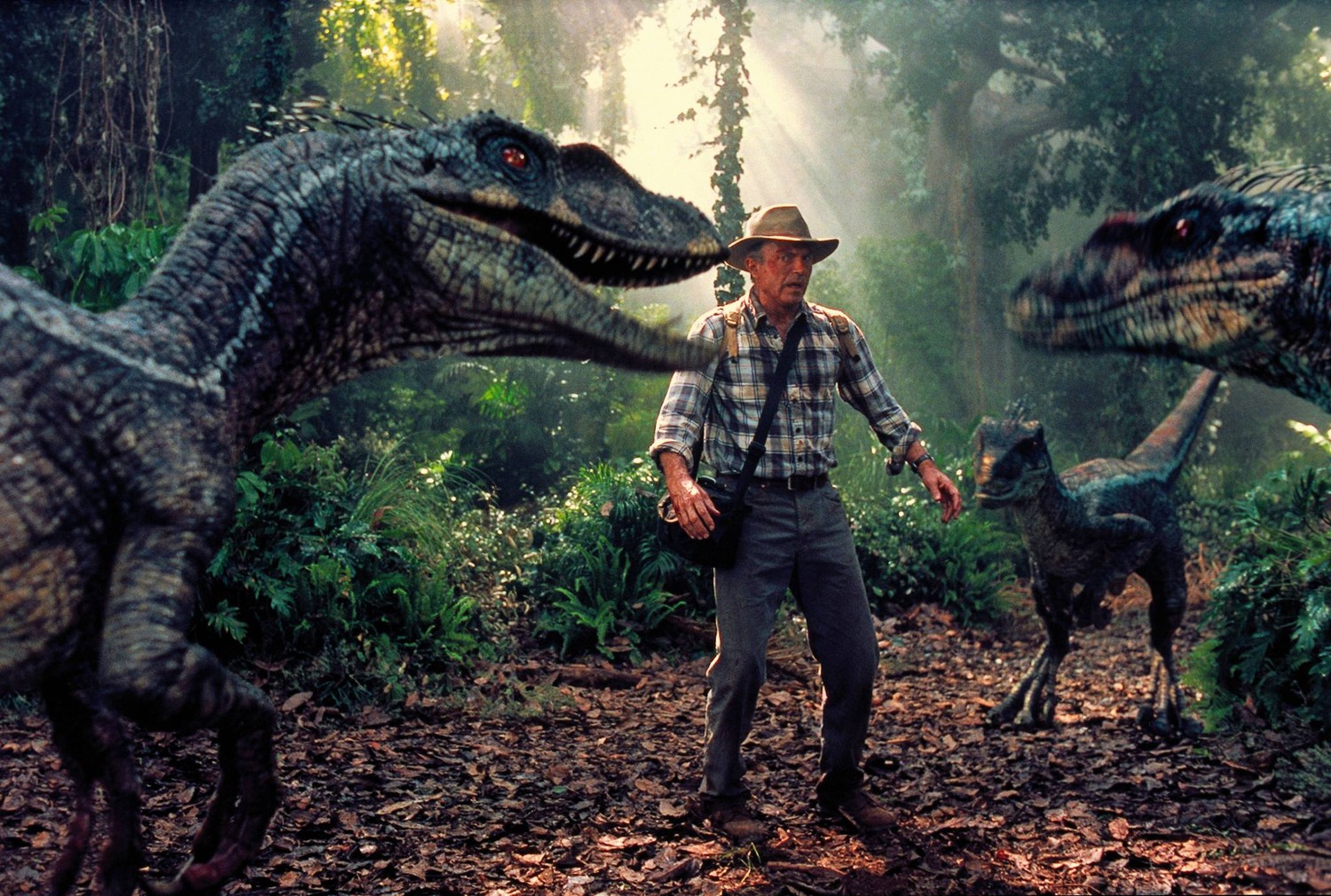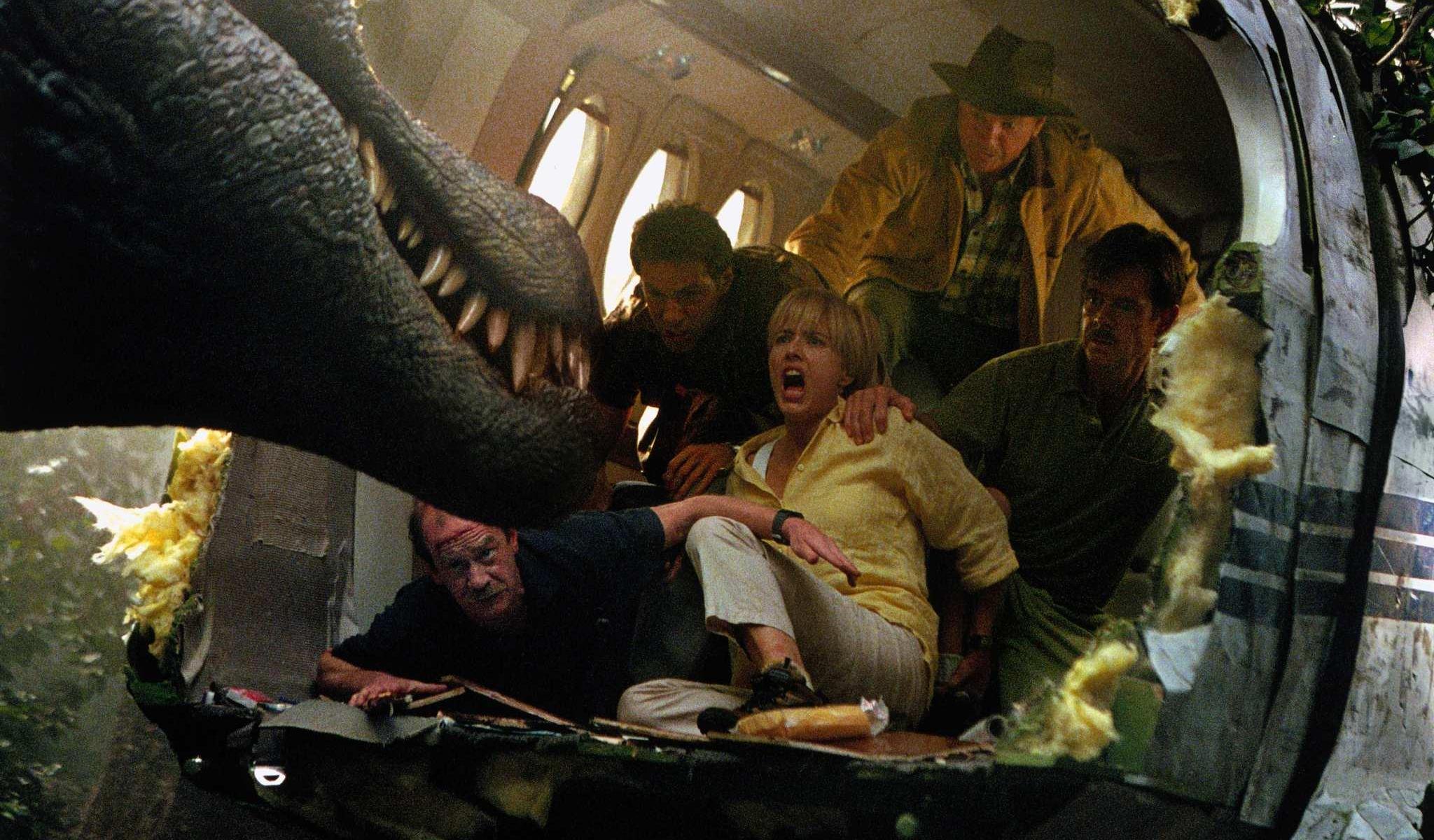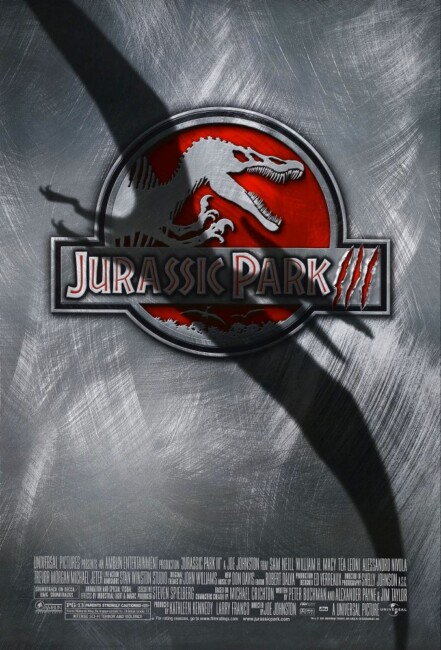USA. 2001.
Crew
Director – Joe Johnston, Screenplay – Peter Buchman, Alexander Payne & Jim Taylor, Producers – Larry Franco & Kathleen Kennedy, Photography – Shelly Johnson, Music Themes – John Williams, New Music – Don Davis, Visual Effects Supervisor – Jim Mitchell, Animation Supervisor – Dan Taylor, Visual Effects/Animation – Industrial Light and Magic, Special Effects Supervisor – Michael Lantieri, Live Action Dinosaurs – Stan Winston Studio (Supervisor – Stan Winston), Production Design – Ed Verreaux. Production Company – Universal/Amblin Entertainment.
Cast
Sam Neill (Dr Alan Grant), William H. Macy (Paul Kirby), Tea Leoni (Amanda Kirby), Alessandro Nivola (Billy Brennan), Trevor Morgan (Eric Kirby), Michael Jeter (Udesky), Laura Dern (Dr Ellie Sattler), John Diehl (Cooper), Bruce A. Young (Nash)
Plot
Dr Alan Grant is approached by wealthy Paul Kirby and his wife Amanda who offer a substantial donation to his research if Grant will act as tour guide for a flight over Isla Sorna. Grant agrees but once there the Kirby’s instead land the plane and it becomes apparent that Grant was duped. Grant discovers that the real purpose of the Kirby’s journey is to search for their son Eric who went missing on the island after a parasailing accident. Within a very short space of time, the party find themselves being hunted by dinosaurs at every turn.
Jurassic Park (1993) was one of the landmark films of the 1990s. Not only was there its amazing box-office success, or its revitalising the flagging career of Michael Crichton, or even the host of other monster movies that followed in its claw prints – Carnosaur (1993), Loch Ness (1996), Godzilla (1998), Mighty Joe Young (1998), Deep Blue Sea (1999), Bats (1999) et al – but its’ true importance was that it gave CGI a massive boost. It was not the first film to use CGI but it was the biggest success at integrating CGI and live-action in such a way that the heretofore impossible could be realised. It was followed by a host of other films not just creating monsters but revisiting all manner of filmic genres – the disaster movie – Twister (1996), Dante’s Peak (1997), Titanic (1997), The Perfect Storm (2000); the ghost story – The Haunting (1999); the war movie – Pearl Harbor (2001); the mummy film – The Mummy (1999); even the creation of cartoon films in live-action – Babe (1995), Cats & Dogs (2001) etc – such that CGI’s rendering of the impossible now occurs with routine regularity.
Steven Spielberg delivered a sequel to Jurassic Park, The Lost World: Jurassic Park (1997), which was disappointingly poor. It is probably Spielberg’s worst film. For Jurassic Park III, Spielberg turned the directorial reins over to Joe Johnston, a former Industrial Light and Magic art director on the Star Wars sequels among others, who debuted as director with the delightful Honey, I Shrunk the Kids (1989) and has been a regular fantasy genre director since with the likes of Rocketeer (1991), The Pagemaster (1994), Jumanji (1995) and the subsequent The Wolfman (2010), Captain America: The First Avenger (2011) and The Nutcracker and the Four Realms (2018).
A couple of months out from its release, the prospects for Jurassic Park III did not seem very promising. In an unprecedented step, William H. Macy spoke out to the press about the fact that the film was being shot without a completed script and that Steven Spielberg, despite having an Executive Producer credit, had never made an appearance on the set. This quickly flamed the scent of disaster. Universal attempted damage control by sending Joe Johnston out to do interviews with a number of high-profile film magazines where he valiantly tried to claim that films commonly shoot without completed scripts and that it was not as bad as had been made out.

From such expectation, one can at least say that Jurassic Park III is not the disaster expected. In fact, it is a better sequel than The Lost World: Jurassic Park was. The big disappointment of The Lost World was that it did nothing new, it offered only more of the same, whereas Jurassic Park III does what a sequel should – it takes the basic menace from the original and adds a series of new variations – the spinosaurus and in particular the pterodactyls – while also exploring other possibilities that the regular creatures hold – like the idea that the velociraptors had highly developed intelligence and language.
In truth, for all that was said about the lack of script, Jurassic Park III is a film where it hardly matters. It seems more like William H. Macy’s issue was that he was a small cog in a giant blockbuster machine. The human characters here are simple sketches – there is dialogue and banter between them but this is a film where the actors are only supporting the CGI animators and the film is less scripted than it is storyboarded. It is a film that has been construed entirely in terms of set-pieces.
Here Joe Johnston at least provides a series of set-pieces that are as enthralling as any in Jurassic Park – the spinosaurus battering and rolling the party about in the severed tail end of the plane; the velociraptor attack in the ruined lab; the pterodactyl attack and Alessandro Nivola’s improbable but daring parasail rescue; the spinosaurus attack on the survivors in a cage on the back of a barge.

Joe Johnston sets one of these sequences up ever few minutes and the film slams and bangs with impressive regard whenever the dinosaurs appear. However, there is nothing else that connects the sequences together. Occasionally, Johnston displays a sense of humour, like cutting between a ferocious dinosaur attack and Barney on a tv screen, but most aspects of the story – the issue of the raptors intelligence, the parasail, the eggs, the satellite phone – are heavily signposted for later in the film and the ending contains a ludicrous (literal) rescue by the seventh cavalry.
One of the more interesting names on the credits is that of co-writer Alexander Payne, who became the multiple Academy Award nominated/winning director/writer of films such as Election (1999), Sideways (2004) and Downsizing (2017).
A Jurassic Park IV was announced off and on for more than a decade after this film came out before it finally emerged with Jurassic World (2015), followed by Jurassic World: Fallen Kingdom (2018) and Jurassic World: Dominion (2022), as well as the animated tv series spinoff Jurassic World: Camp Cretaceous (2020-2).
(Nominee for Best Special Effects at this site’s Best of 2001 Awards. No. 6 on the SF, Horror & Fantasy Box-Office Top 10 of 2001 list).
Trailer here


